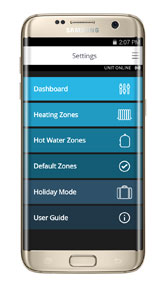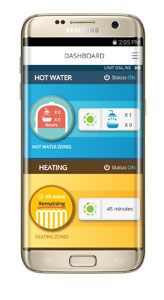-red hot water from the Red Hat app-
Terry Madigan, CEO, Systemlink, writes
“As a manufacturer of zoned heating systems, we saw an opportunity to help our users to control their energy use. Millennials have grown up using mobile phones and computers, so they expect to be able to control their household systems through an app.
In response to our customers’ interest in mobile apps that monitor utilities, we set about developing a cylinder storage system, with additional sensors and relays, that could be controlled through an intuitive user interface running on a smartphone. We wanted to provide our customers with control and feedback, helping them to better manage their electricity, gas and water consumption.
Connecting our hot water storage cylinder
We decided to develop a smartphone app that could communicate with a Home Interface Device (HID) control panel mounted in the home, to control our new AquaEko  cylinder, which heats domestic hot water as it is required.
cylinder, which heats domestic hot water as it is required.
Traditional water and space heating boilers work by filling up a cylinder with cold water and heating the entire volume of water to the required temperature. This can result in some of the water being heated unnecessarily, which can waste energy and increase consumers’ heating bills.
Systemlink's patent-pending AquaEko system fills the cylinder with hot water from the top, allowing the required volume of hot water to be drawn off as it is needed. This can help to save energy and reduce water consumption and household costs. It also reduces recovery time, so that householders don’t have to wait for water to heat up so that they can take a shower.
Developing the IoT app
An HTML5 app was developed, enabling consumers to remotely control their home heating and hot water system and monitor their usage over the year from their mobile devices.
Middleware is important for interfacing between IoT devices and mobile apps used to control them. We know that mobile apps can require frequent updates and need to be managed throughout their lifecycle, so we needed to select a mobile app infrastructure that could reduce the management burden by enabling updates to be pushed from the cloud. By selecting Red Hat’s enterprise-grade Mobile Backend as a Service (MBaaS), with an API infrastructure, we are able to support the IoT app using cloud-based middleware that integrates with Systemlink’s databases and pushes updates to customers’ devices as required.
Selecting the right IoT partners
While we were open to working with a third party developer to develop the IoT app, and manage it on an ongoing basis, we wanted to ensure that we could update and take control of the app, without being locked into any particular system or development environment. The Red Hat Mobile Application Platform uses open technologies and standard toolkits, enabling developers to use the tools that they are already familiar with. By employing a microservices-based architecture, Red Hat customers have the ability to innovate, develop and deploy apps in response to evolving business requirements. The Node.js-based platform can be hosted in the cloud and uses open standards that allow customers greater flexibility.
We also worked with Dublin-based developer of customised engineering hardware, mSemicon, to create the IoT sensors and controllers for our AquaEko boiler. Red Hat Mobile created a custom cloud API to integrate with mSemicon’s hardware, enabling the app to work with the controller.
The mSemicon controller is connected through a gateway to the Red Hat server and any updates are pushed from the HID control panel via the LoRa™ wireless network to the Red Hat server, which talks to the app. Time stamped images are updated by the mSemicon controller and the newest requests are acted on.
Two of the biggest enemies of wireless signals are concrete and water. We found that LoRa is a good low power network, which provides our IoT products with greater range, so we chose the LoRa wireless network to transmit data to and from the AquaEko device.
Giving customers control over consumption
AquaEko's “One Touch” hot water or heating zone boost facility gives users easier control over their domestic hot water and heating.
We specified a simple user interface and the app developed by Red Hat Mobile has a front page that is self-explanatory. As soon as you open it on your phone it takes you straight into the controls.
The volume of domestic hot water generated is displayed in pictorial form on the Systemlink AquaEko app, showing the numbers of baths or showers that are available to use, rather than litres that have been heated. This makes the app more intuitive and helps our customers to control the amount of energy they use to heat their domestic hot water.
Future plans:
The Systemlink AquaEko system already has a frost setting that automatically turns on the heating so that the home temperature should never fall below 5°C. We are considering including intelligent learning on the system so that it can adjust to local weather conditions. In future, we may integrate with databases such as the local weather report to enable returning travellers to be alerted if there is a cold snap.
The hospitality sector, care homes and hospitals could benefit from our IoT-enabled system. Guests, residents and patients must always have hot water available, but there is also an optimal quantity that can be kept heated without unused hot water going cold.
Now that we’ve developed our AquaEko app we’re considering how this could be applied to other domestic devices. Essentially, our IoT controller and app is a remote control switch. The relays could be expanded to control other household items such as electric blinds and lighting, using the Red Hat cloud-based mobile platform for ongoing management, security and scalability .



Add new comment